Multi-Piece Pattern Introduction
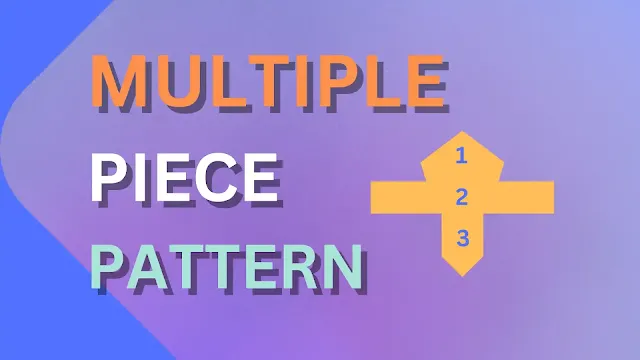
|
| Multiple Piece Pattern In Casting |
This is done by using a multi-piece pattern where the pattern is made in three pieces and assembled together to make a mould cavity in the cope, cheek and drag part of the mould.
I have written a detailed article here discussing multi-piece patterns, advantages, disadvantages, design, the difference between split patterns and multi-piece patterns and application.
{tocify} $title={Multi Piece Pattern Table of Content }
Multi-Piece Pattern In Casting
What is a multi-piece pattern in a foundry?
A multiple-piece pattern is a pattern that rests in the cope, cheek and drag part of the mould to create a mould cavity for making complex intricate shape casting that cannot be produced using a solid piece pattern and split-piece pattern in the sand casting process.
The split pattern rests only in the cope and drag section of the mould while the multi-piece pattern rest in the three section of the mould namely cope, drag and cheek.
When the pattern is made in three parts the top part (1) will rest in the cope section of the mould. The middle part (2) will rest in the cheek section while the last part (3) will rest in the drag section of the mould as shown below in diagram (a).
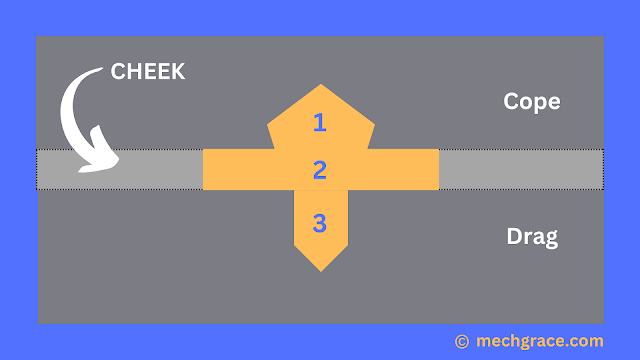
|
| (a) Multi Piece Pattern In The Sand Mould |
This three-piece pattern creates a mould cavity in all three sections of the sand mould for casting complex shape products shown below in diagram (b).
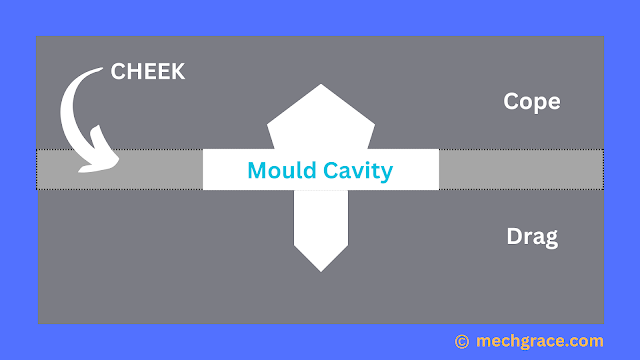
|
| (b) Mould Cavity by Three Piece Pattern |
The cheek part is the middle section of the mould which is along the parting line between the cope and drags sections that do not exist for single-piece patterns and split-piece patterns mould.
When the pattern maker designs casting proper pattern-making allowances are given to the pattern.
The molten metal is poured into the mould cavity made from the three-piece pattern as shown in diagram (c) below.
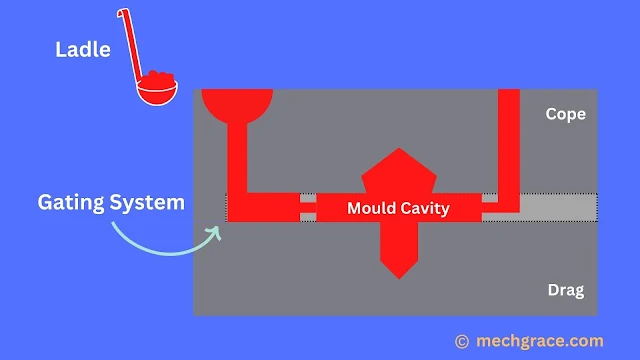 |
| (c) Mould Cavity Made From Multiple Piece Pattern |
Once molten metal solidifies a three-piece casting is formed as shown in diagram (d) below.
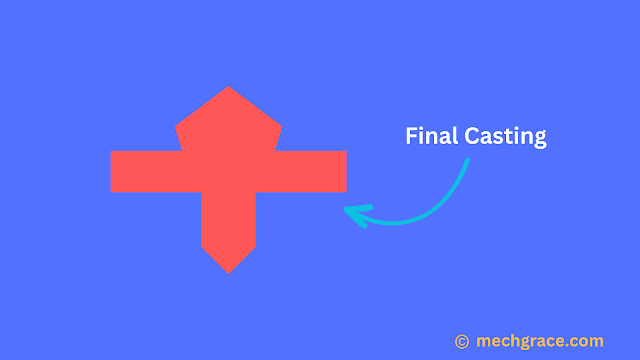
|
| (d) Casting Made From Multi Piece Pattern |
Multi Piece Pattern & Split Pattern Difference
What is the difference between a split pattern and a multi-piece pattern in the casting process?
The difference between split-piece patterns and multi-piece patterns is as follows:
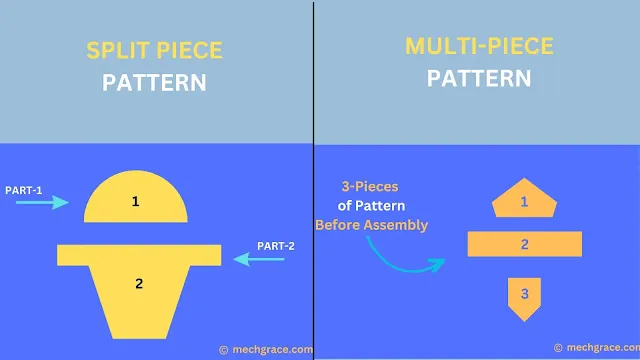 |
| (e) Difference between split piece pattern and multi-piece pattern |
| Split Pattern | Multi Piece Pattern In Casting |
|---|---|
| 1) The pattern is split into two parts and joined together with dowel pins so both parts will sit in the cope and drag portion of the mould. | 1) The pattern is split into three parts and joined together with dowel pins so they can sit in the cope, cheek and drag portion of the mould. |
| 2) The flexibility of producing complex sand casting parts is more than solid-piece patterns but less than multi-piece patterns. | 2) The flexibility of producing complex sand casting parts is more than solid patterns and split piece patterns. |
| 3) Mould-making process is less complex for split patterns as only mould is to be made in two parts (cope and drag). | 3) The mould-making process is more complex than a split pattern and solid pattern as mould is to be made in three parts (cope, drag and cheek). |
| 4) Maintenance of this pattern is lower than three piece pattern. | 4) Maintenance of the pattern is higher than the solid and split patterns in casting. |
| 5) Patterns with larger height and depth cannot be accommodated in the mould as compared to multi-piece patterns in casting. | 5) Patterns with larger height and depth can be accommodated in the mould as compared to split patterns in casting. |
| 6) Pattern-making is less time-consuming compared to multi-piece patterns. | 6) Pattern-making is more time-consuming compared to split-piece patterns. |
| 7) The cost of production of the pattern is more than the multi-piece pattern but less than the solid pattern. | 7) The cost of production of the pattern is more than the split pattern and solid piece pattern. |
| 8) Used to produce valves, caskets and handles. | 8) Used to produce three-part oil tanks, vessels, switch gears and impellers. |
Multi Piece Pattern In Casting Advantages and Disadvantages
Advantages of Multi Piece Pattern In Casting
- Cores can be utilized in the cheek section to produce cavities in casting.
- A three-piece pattern brings more flexibility for foundry men in the casting process when designing complex patterns as compared to single-piece patterns and split-piece patterns.
- The product of desirable shape, size and weight can be produced as the pattern is split into three pieces.
- Replacement of the damaged pattern pieces is easier than single-piece patterns, segmental patterns and sweep patterns as only damaged parts should be replaced. The entire pattern is not scrapped.
- Each section of the three-piece pattern can be designed separately according to the demand.
Disadvantages of Multi Piece Pattern In Casting
- Not suitable for producing a casting in a small volume.
- Skilled pattern makers, tools and equipment are a necessity.
- The cost of production of the pattern is higher than the solid and split patterns.
- The mould-making process is costly, time-consuming and requires more labour costs for three-piece patterns.
- The cost of production of the pattern should be justified with casting orders.
- The pattern-making process is complex as all three piece needs to be aligned and assembled.
- Designing a three-piece pattern, joining, aligning and handling is more challenging in the foundry.
- All three parts of the mould box need to be aligned together without any mismatch to produce uniform sound casting.
Application of Multi-Piece Pattern
What are multi-piece pattern or three-piece pattern applications and uses?
The multi-piece pattern in casting examples is as follows:
- Industrial valves such as oil valves, gas valves and water valves.
- Electrical switch gears.
- Electrical brackets.
- Electronic connector housing.
- Golf club heads and archery equipment.
- Power lever door lock assembly.
- Vessels and circuit breakers.
- Three-part oil tank.
- Impeller for pumps.
- Housing, covering and casing.
- Sculptures.
- Three-piece shaft and cylinders.
- Lap and dowel joints.
Multi-Piece Pattern In Casting MCQ (Multiple Choice Question & Answer) / Practice Questions
1) Multi-piece pattern rest in which part of the mould?
2) Multi-piece pattern in the casting process consumes more resources and increases the cost of the pattern production than which of the following patterns?
3) Time, cost and labour are required for making a sand mould for the multi-piece pattern higher than the solid and split pattern? (State if the statement is true or false)
4) Multi-piece pattern has higher flexibility in designing casting than which of the following pattern?
5) Match the following solid, split and multi-piece patterns with the right pattern design.
Multi Piece Pattern Summary
The multi-piece pattern or three-piece pattern is one of the patterns among 17 types of pattern in casting.
All three parts of the pattern are made separately and assembled together making it one pattern which is used to produce a cavity in the mould.
As shown below in diagram (f) pattern before assembly is split into three parts according to the dimensions of cope, cheek and drag for making a three-piece casting according to the consumer's requirement and order.
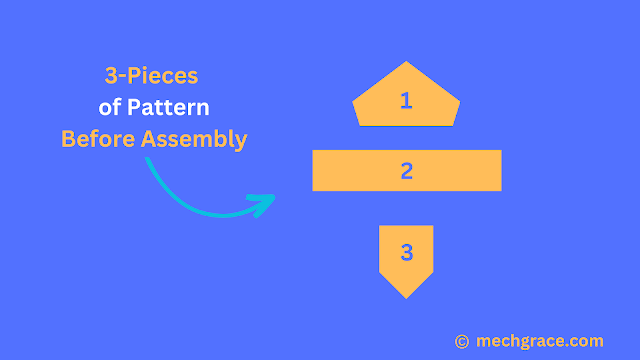
|
| (f) Multi-Piece Pattern |
All these three pieces of the pattern shown above will be assembled to form a single three-piece pattern to produce large-size castings such as three-piece tanks, mitre joints, sculptures, brackets and connectors.
Pattern maker ensures that the right material is selected for the three-piece pattern from various types of pattern making material available.
